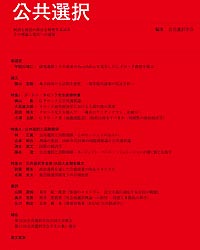Volume 2015, Issue 64
Displaying 1-16 of 16 articles from this issue
- |<
- <
- 1
- >
- >|
Foreword
-
2015Volume 2015Issue 64 Pages 3-5
Published: 2015
Released on J-STAGE: March 29, 2023
Download PDF (186K)
Articles
-
2015Volume 2015Issue 64 Pages 6-29
Published: 2015
Released on J-STAGE: March 29, 2023
Download PDF (438K)
Featured Articles I
-
2015Volume 2015Issue 64 Pages 30-44
Published: 2015
Released on J-STAGE: March 29, 2023
Download PDF (338K) -
2015Volume 2015Issue 64 Pages 45-50
Published: 2015
Released on J-STAGE: March 29, 2023
Download PDF (234K) -
2015Volume 2015Issue 64 Pages 51-55
Published: 2015
Released on J-STAGE: March 29, 2023
Download PDF (224K) -
2015Volume 2015Issue 64 Pages 56-60
Published: 2015
Released on J-STAGE: March 29, 2023
Download PDF (240K)
Featured Articles II
-
2015Volume 2015Issue 64 Pages 61-62
Published: 2015
Released on J-STAGE: March 29, 2023
Download PDF (147K) -
2015Volume 2015Issue 64 Pages 63-81
Published: 2015
Released on J-STAGE: March 29, 2023
Download PDF (385K) -
2015Volume 2015Issue 64 Pages 82-100
Published: 2015
Released on J-STAGE: March 29, 2023
Download PDF (383K) -
2015Volume 2015Issue 64 Pages 101-118
Published: 2015
Released on J-STAGE: March 29, 2023
Download PDF (452K)
Featured Articles III
-
2015Volume 2015Issue 64 Pages 119-134
Published: 2015
Released on J-STAGE: March 29, 2023
Download PDF (315K) -
2015Volume 2015Issue 64 Pages 135-152
Published: 2015
Released on J-STAGE: March 29, 2023
Download PDF (333K)
Book Reviews
-
2015Volume 2015Issue 64 Pages 153-156
Published: 2015
Released on J-STAGE: March 29, 2023
Download PDF (191K) -
2015Volume 2015Issue 64 Pages 157-159
Published: 2015
Released on J-STAGE: March 29, 2023
Download PDF (175K) -
2015Volume 2015Issue 64 Pages 160-162
Published: 2015
Released on J-STAGE: March 29, 2023
Download PDF (176K)
-
2015Volume 2015Issue 64 Pages 500
Published: 2015
Released on J-STAGE: March 29, 2023
Download PDF (279K)
- |<
- <
- 1
- >
- >|
